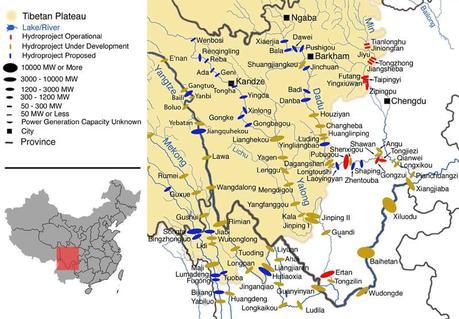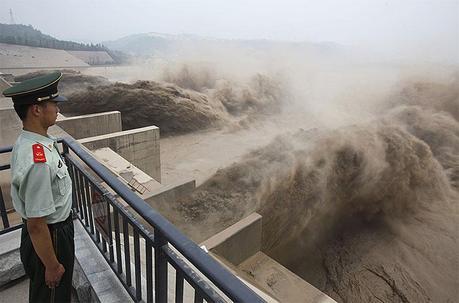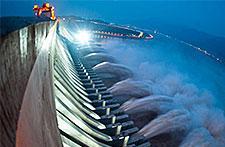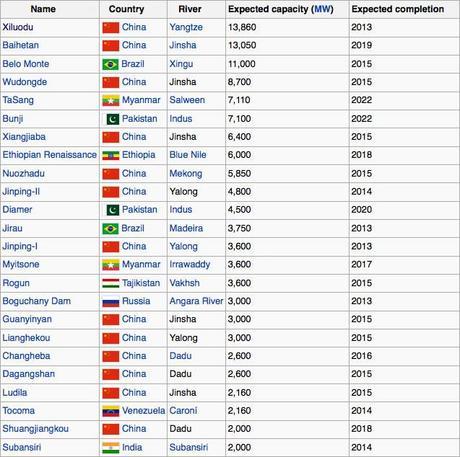 by Charlton Lewis / Environment360
by Charlton Lewis / Environment360
In their search for renewable electric power, China’s engineers have been building mega-dams at a rate unmatched in human history. Many far larger than the Hoover Dam on the Colorado River — which is 221 meters high and capable of generating more than 2,000 megawatts of power — are being constructed on China’s greatest rivers. Best known is the Three Gorges Dam, completed in 2008, which stretches a mile-and-a-half across the Yangtze and can generate ten times the hydropower of the Hoover Dam. Yet the Three Gorges is only a fraction of China’s current dam program.
The government is now engaged in a new expansion of dams in great staircases, reservoir upon reservoir — some 130 in all across China’s Southwest. By 2020, China aims to generate 120,000 megawatts of renewable energy, most of it from hydroelectric power. The government declares that such dams are safe, avoid pollution, address future climate change, control floods and droughts, and enhance human life.
These assertions are largely untrue. Instead, China’s mega-dams block the flow of rivers, increase the chances of earthquakes, destroy precious environments and shatter the lives of millions of people. Rather than benefiting populations with non-polluting power, China’s dam builders are making a Faustian bargain with nature, selling their country’s soul in their drive for economic growth.
Since the 1950s the Chinese have built some 22,000 dams more than 15 meters tall, roughly half the world’s current total. During the 1990s, as economic growth surged and air pollution spurred the need for clean energy, they turned increasingly to huge mega-dams. Protests from environmentalists have helped slow some of the building in recent years. But under the 12th Five Year Plan (2011-2015) the government seems to have cast aside restraint. Opposition has been suppressed and the dam builders are now free to move forward.

Xiaolangdi Dam on the Yellow River in central China’s Henan province.
About 100 dams are in various stages of construction or planning on the Yangtze and its tributaries — the Yalong, Dadu, and Min. Two dozen more will be built on the Lancang, called the Mekong in Southeast Asia, and still more on the last two of China’s free-flowing rivers — the Nu, called the Salween in Burma, and the Yarlung Tsangpo, known as the Brahmaputra in India and the Jamuna in Bangladesh. All these rivers flow off the Tibetan Plateau, a geologically unstable region that averages 4,500 meters (14,800 feet) high. As they flow down through the soft, sedimentary rock, the rivers carve steep canyons, many deeper than the Grand Canyon. The risk of earthquakes is high. Probe International, a Canadian NGO, warned in April 2012 that almost half of China’s new dams are in zones of high to very high seismic risk, and most of the remainder in zones of moderate hazard.
Dams themselves may cause quakes. The seasonal rise and fall of reservoirs places extra stress on nearby rock formations. When the 50-story-high Zipingpu Dam was begun on the Min River in 2001, seismologists from China’s Earthquake Bureau warned that a major fault ran less than a mile away, but they were ignored. In 2007 and 2008, the reservoir filled, with major fluctuations in the water level. In May 2008, the 7.9-magnitude Wenchuan quake occurred only 5.5 kilometers downstream, killing 80,000 people. Since then, more than 50 studies have found evidence that the reservoir triggered small quakes through the fault system, culminating in the large quake.
Five years later, on April 20, 2013, a magnitude-7.0 quake occurred at Ya’an City on the same fault line. Nearly 200 died, more than 5,000 were injured, and thousands made homeless. Fan Xiao, the chief engineer of the Sichuan Geology and Mineral Bureau, believes this quake may have been an aftershock of the Wenchuan quake, thus possibly also dam-related.
By law each proposed dam must go through an environmental impact assessment (EIA), but the process is outdated and flawed. Red tape and corruption prevail. And EIAs have generally only addressed individual projects; until recently, there have been no EIAs for dams in cascades. Since river valleys tend to follow earthquake fault lines, a series of dams down a valley may compound the risk of quakes. Should one dam fail, the rush of water could overwhelm the next dam downstream, causing dams to collapse like dominos. In 1975 the 118-meter Banqiao dam on a tributary of the Huai was breached in a heavy rainstorm. Numerous dams downstream gave way in succession to produce a lake of more than 7,300 square kilometers. Six counties were inundated. By a conservative estimate, 26,000 died in the flooding and another 145,000 in the ensuing epidemics and famine.
Several major cascades are taking shape. On the Yangtze and its upstream stem, the Jinsha, a series of some 15 dams are planned, under construction, or completed. Among them, four huge dams above the Three Gorges — including the Xiluodu, which is 280 meters high — are expected to be completed by 2020. Along the Yalong, a major tributary of the Yangtze’s, a cascade of 21 major dams is planned. On the Dadu, which parallels the Yalong, there will be 17 dams, among them the recently approved 314-meter high Shuangjiangkou, only 10 meters lower than the Eiffel Tower. On the Lancang, headwaters of the Mekong, a cascade of 26 dams is planned. The still free-flowing Nu, or Salween, River will have as many as 13 dams. On a map, each projected cascade looks like a string of beads.
Although hydroelectric dams produce considerably fewer carbon emissions than coal-fired power plants, China’s assertions that dams provide clean energy are substantially untrue. The rotting of inundated trees and vegetation in reservoirs emits the greenhouse gasses, carbon dioxide and methane, that rise from reservoir surfaces. Whenever water levels drop, rotting vegetation is again exposed and methane emissions increase. Estimates of emissions vary widely, depending on the climate where the dam is built, the amount and type of vegetation flooded, and the depth and age of the reservoir. Over a projected lifetime of a dam in temperate regions, emissions could be from roughly one-third to nearly two-thirds that of a natural gas plant. In warm and densely forested areas, such as China’s southwest, the emissions could be higher, particularly in a plant’s early years of operation. Dam building also includes indirect emissions from development of a dam site, manufacture and transport of materials and equipment, waste disposal, and, eventually, decommissioning.
Nor do big dams protect from floods and droughts. They store water during the wet season and release it during the dry season, thus reversing the natural flow of rivers. Deprived of their annual inundations, downstream marshes, lakes, and wetlands dry out and can no longer absorb floodwaters. Since the Three Gorges Dam was completed, the Dongting Lake in Hunan and the Poyang Lake in Jiangxi, which once absorbed the Yangtze overflow, have shrunk dramatically, and many smaller lakes have entirely disappeared. During the record-breaking summer flood of 2010, the Three Gorges reservoir rose to 12 meters above “alarm level.” To protect the dam, its operators opened the floodgates to the maximum.

The Three Gorges Dam, which opened in 2008, is the world’s largest producer of electric power.
Downstream some 968 people were killed, 507 more were missing and economic losses totaled $26 billion. The great dam survived its first test, but its floodplain is unlikely to contain big floods in the future.
Drier floodplains intensify droughts; when rivers diminish, dam operators preserve their hydropower potential by withholding water. During the January to April 2011 drought, water levels in the Lower Yangtze valley dropped steeply, stranding thousands of boats and creating power shortages in central and eastern China. On the upper reaches of the Yellow River to the north, a string of large dams has exacerbated recent droughts on the North China Plain. In addition, as the planet warms, glacial melt will diminish river flows, reservoirs will not fill, and dams may then prove to be a colossal boondoggle.
The damage that dams cause to river ecosystems is immense, turning free-flowing waterways into lifeless lakes, killing plants and trees, blocking fish migration and breeding, driving species to extinction, and devastating established patterns of human life. A looming example of such disruption is the threat hanging over the Three Parallel Rivers area in Yunnan Province, where the Jinsha, Lancang, and Nu flow through separate gorges as deep as 3,000 meters in an area less than 75 kilometers across. Declared a World Heritage Site by UNESCO in 2003, this spectacular region is one of the most environmentally diverse and fragile on earth. Hydropower companies are now planning some 25 dams in this zone.
The Xiaonanhai Dam, to be constructed above the Three Gorges reservoir, will sever the last remaining migratory route that fish need in order to reproduce, including rare and endemic species such as the paddlefish (the biggest freshwater fish in the world) and the Dabry’s sturgeon, whose numbers have already been drastically reduced. The Chinese river dolphin was declared extinct in 2006.
Dams also pollute. Their reservoirs capture chemicals, fertilizer runoff, human waste and all kinds of trash. During the 2010 flood, floating refuse backed up behind the Three Gorges Dam over an area of more than 50,000 square meters, so thick, according to the Hubei Daily “that people can literally walk on the water’s surface.” Without annual floods, dammed rivers fail to flush contaminants downstream. As the rivers percolate into the ground, they deliver pollutants into the aquifers — this in a country where nearly 60 percent of groundwater in 198 cities has been measured as poor, according to a report this year by the Ministry of Land and Resources.
Dam reservoirs trap silt, which decreases their storage capacity and reduces power generation. Silt no longer carries nutrients down the rivers, and without protective silt, salt water encroaches on estuaries and damages croplands. Estuaries also become more vulnerable to rising sea levels.
Great dams also devastate human populations. During the past half-century about 16 million Chinese have been relocated to make way for hydroelectric projects, and of these 10 million live in poverty, according to China Youth Daily. With each new project, communities are fractured and lives disrupted. People are relocated to new towns or forced to resettle on degraded land. Often they do not receive promised resettlement money or job training, driving many to migrate again. The Three Gorges Dam alone has submerged 13 cities, 140 towns, and 1,350 villages. By 2007 its reservoir had displaced some 1.4 million people.
When the two-football-fields-high Pubugou dam was built on the Dadu River between 2001 and 2010, 100,000 persons were driven from their homes. Evictions began even before final approval in 2004. Tens of thousands rioted against the dam, reportedly one of the largest rural demonstrations since the founding of the People’s Republic of China.
China’s dam projects also threaten livelihoods in other countries. Of the watersheds discussed above, only the Yellow and the Yangtze are wholly domestic. Outside of China the Lancang/Mekong, Nu/Salween, and Yarlung Zangbo/Brahmaputra flow through several countries of Southeast Asia, India, and Bangladesh. Since 1997 China’s government has declined to sign the United Nations water-sharing convention that would govern its major transnational rivers, yet it continues to build dams without consulting its downstream neighbors.
On the Mekong, China’s dams are affecting agriculture and fisheries. In Laos and Thailand, crops are regularly washed away before harvest time as upstream dams release their water. Nutrient-rich silt no longer reaches the Mekong delta, which is reducing fish stocks. In Burma and Thailand, environmental groups have spoken out about the threats to wildlife and populations from dams now planned for China’s Nu/Salween. A colossal 38,000-megawatt project has been proposed at Motuo on the Yarlung Tsangpo in Tibet. The project would pose a serious threat not only to the Tibetan Plateau but to India and Bangladesh, where the Yarlung becomes the Brahmaputra and Jamuna rivers.
China’s unprecedented construction of dams makes a mockery of the larger vision expressed in its current Five Year Plan to develop clean energy, reduce pollution, and protect the environment. A more accurate vision may be that of the Sichuan geologist Fan Xiao in his 2011 letter opposing the Xiaonanhai Dam.
“These major projects will be synonymous with the worst excesses of this era, and the mark they will leave in history is going to be very difficult to erase.” Fan goes on to warn that the great dams will become “a source of permanent grief and regret for future generations yet unborn.”

China is engaged in an unprecedented dam-building boom, with 130 hydroelectric dams already completed, under construction, or planned in south-central China alone. This chart shows that of the 24 largest hydropower stations being built worldwide, 13 are in China.

